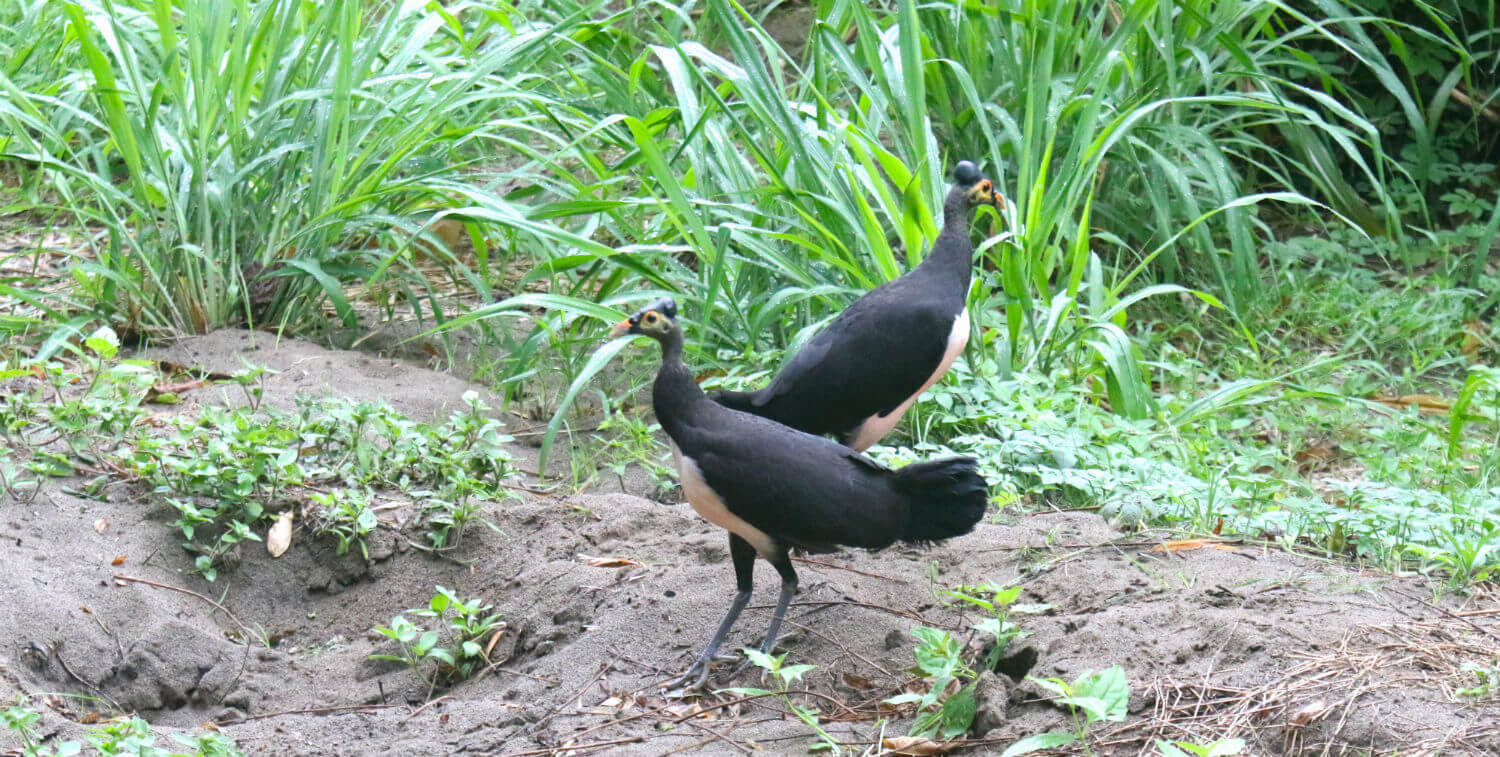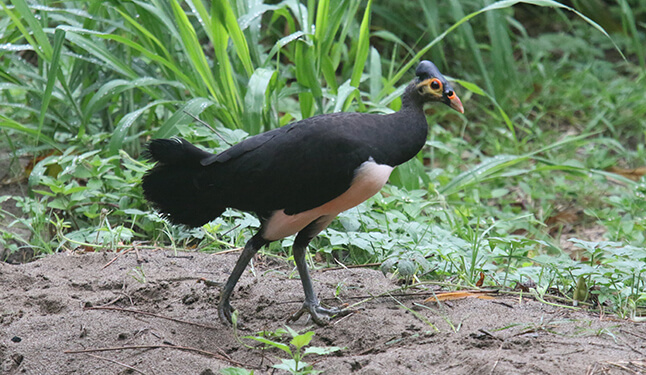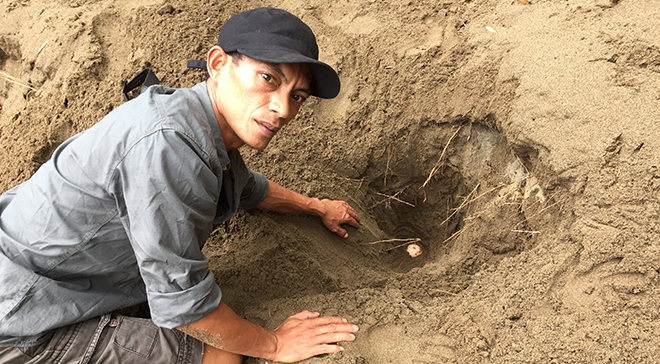
Endangered Indonesian Bird Feels The Heat To Reproduce
11 April 2016
The world of birds is full of surprises. Reproduction strategies vary from species to species. However, one common element is the selection of a site where eggs can be laid and incubated by one or both parents. The nests where eggs are laid by female birds are built of various material such as moss, leaves, twigs or branches, or can be located in tree cavities, on cliff ledges or dug into the ground.
In Sulawesi, Indonesia, one species has a different and unique reproduction strategy.
The maleo (Macrocephalon maleo) belongs to the family Megapodiidae that includes 21 species distributed in Sulawesi, Moluccas (Indonesia), Sabah (Malaysia), Nicobar (Indian Union Territory), the Philippines, Indonesia, Australia, New Guinea, and a few small islands of Polynesia, Micronesia and Melanesia (Mariana Islands, Palau, Tonga, Vanuatu).
Maleos are endemic to Sulawesi. They can be found from sea level to 1,200 meters of altitude, and they frequent the rain forest. This species, larger than a chicken in size, is mostly terrestrial, but it is capable of flying short distances. Sulawesi is known for its volcanic activity, and maleos have found a way to exploit this natural phenomenon.
Maleos do not build nests, nor do they incubate their eggs. Instead male and female maleos look for areas of volcanic soil that are heated by natural geothermal activities, then dig a deep hole — up to 1 meter deep — for the female to lay one very large egg and cover it with sand before leaving. Alternatively, the heat necessary for the incubation of the egg is provided by solar radiation on dark gray sand. Maleo parents will never see their egg hatching, feed their baby or raise their young as most bird species do.

So what happens once the egg has been buried under up to a meter of volcanic sand? About 80 days later, baby maleos dig their way up to the surface as a baby sea turtle would do. This task is exhausting and can take up to three days to complete. Once at the surface, the baby bird is on its own. There are no parents to provide its education. Its survival depends entirely on its own skills. As soon as it has emerged from the sand, the baby maleo runs to find shelter in the forest, and will hopefully reach adult size 18 to 22 months later.
The Indonesia National Park Service, with the support of international conservation NGOs such as the Wildlife Conservation Society (WCS), is developing programs to conserve this iconic species, which is threatened by habitat degradation, egg harvesting, and nest raiding by feral animals. Some nesting sites have been monitored daily for more than 15 years, and eggs are collected and placed in a semi-natural hatchery where they are protected from predators. Once the eggs hatch, the baby maleos are placed in an aviary until they reach the age of one month, and then are released into the wild. This management practice increases the survival rate of baby maleos, since they are extremely vulnerable to predators during their first month. Such conservation efforts have resulted in an increase in the number of adult maleos observed at these managed nesting sites.

I had the privilege to observe maleos in North Sulawesi at Muara Pusian Station in Bogani Nani Wartabone National Park. At 5:30 a.m., 30 minutes before sunrise, Arief Rahman and Marthin Makarunggala, two Indonesian conservationists working for the local NGO CeleBio, accompanied me silently to the hide under the supervision of Tomo Lomamai, the nest guardian at Bogani Nani Wartabone National Park. An hour later, we saw the first pair of maleo sitting on top of a rock, emerging from the forest on the opposite bank of the river. For 20 minutes the two birds scanned the surroundings before crossing the river via a powerful flight and landed right in front of us on the sandy bank. The two birds started walking around, looking for a proper nesting place. This first pair was soon joined by a second, and then a third pair, as maleos use communal nesting sites. The birds started digging the sand with their powerful legs. When the hole was deep enough, usually between 60 cm and 100 cm deep, the female laid its egg and quickly covered it with sand. We then realized that all the craters scattered along the sandy bank, some of them reaching 2 meters in diameter, were indeed maleo nests! On the morning of our observation, two females laid eggs. Around 10 a.m., the six maleos left the nesting site to find shelter in the forest. Tomo went and dug out the two eggs to place them in a protected natural hatchery. The incubation takes on average 79 days at a temperature between 32°C and 39°C.
We then walked to the aviary established in a quiet spot along the river, where a one-month-old maleo was awaiting its release. Tomo generously offered me the unique opportunity to release the bird. I firmly grabbed the large quail-size bird, showed the bird the direction it should aim at, and then lifted it in the air before releasing it. The young bird flew straight across the river and landed in the dense vegetation where it could hide from potential predators, such as the pair of brahminy kites that had established a nest on a tree facing the aviary and were busy feeding a chick.
According to BirdLife International, the maleo’s global population is estimated between 4,000 and 7,000 pairs. A decline in population size has been observed in the past few decades and is likely to continue. Of the 142 known communal nesting sites, 48 have been already abandoned. The species was listed as Endangered by the IUCN in 2002. This situation justifies the efforts dedicated by the Indonesian government and its civil society partners such as WCS for protecting the nesting sites. As a member of the biodiversity conservation community, I applaud this important initiative that has been sustained for over 15 years with support from WCS. Conservation successes like this one need to be celebrated.